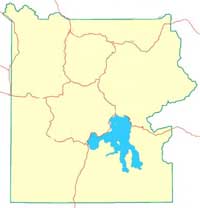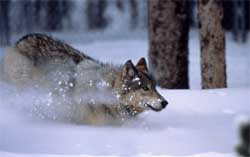 Yellowstone National Park is a U.S. National Park located in the states of Wyoming, Montana, and Idaho. Yellowstone is the first and oldest national park in the world and covers 3,470 square miles (8,980 km²), mostly in the northwest corner of Wyoming. The park is famous for its various geysers, hot springs, and other geothermal features and is home to grizzly bears and wolves, and free-ranging herds of bison and elk. It is the core of the Greater Yellowstone Ecosystem, one of the largest intact temperate zone ecosystems remaining on the planet. The park was named for the yellow rocks seen in the Grand Canyon of the Yellowstone—a deep gash in the Yellowstone Plateau that was formed by floods during previous ice ages and by river erosion from the Yellowstone River. Yellowstone National Park is a U.S. National Park located in the states of Wyoming, Montana, and Idaho. Yellowstone is the first and oldest national park in the world and covers 3,470 square miles (8,980 km²), mostly in the northwest corner of Wyoming. The park is famous for its various geysers, hot springs, and other geothermal features and is home to grizzly bears and wolves, and free-ranging herds of bison and elk. It is the core of the Greater Yellowstone Ecosystem, one of the largest intact temperate zone ecosystems remaining on the planet. The park was named for the yellow rocks seen in the Grand Canyon of the Yellowstone—a deep gash in the Yellowstone Plateau that was formed by floods during previous ice ages and by river erosion from the Yellowstone River.

Yellowstone is at the northeast tip of a smooth U-shaped curve through the mountains, which is now the Snake River Plain. This curved plain was created as the North American continent drifted across a stationary volcanic hotspot beneath the Earth's crust. This hot spot used to be near what is now Boise, Idaho, but North America has drifted at a rate of 45 mm a year in a southwestern direction, shifting the hot spot to its present location.

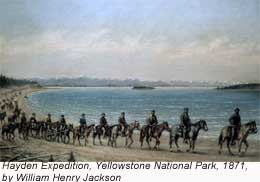 In 1806 a member of the Lewis and Clark Expedition named John Colter left the Expedition to join a group of fur trappers and was probably the first non-Native American to visit the region and make contact with the Native Americans there. Mountain man Jim Bridger later returned from an 1857 expedition to the park's area and told tales of boiling springs, spouting water, a mountain of glass and yellow rock. These reports were largely ignored, however, because Bridger was known for being a "spinner of yarns." Nonetheless his stories did arouse the interest of explorer and geologist F.V. Hayden who in 1859 started a two-year survey of the upper Missouri River region with Bridger as a guide and with United States Army surveyor W.F. Raynolds. The party was able to reach the approaches to the Yellowstone region but was not able to go any further due to heavy snows. In 1806 a member of the Lewis and Clark Expedition named John Colter left the Expedition to join a group of fur trappers and was probably the first non-Native American to visit the region and make contact with the Native Americans there. Mountain man Jim Bridger later returned from an 1857 expedition to the park's area and told tales of boiling springs, spouting water, a mountain of glass and yellow rock. These reports were largely ignored, however, because Bridger was known for being a "spinner of yarns." Nonetheless his stories did arouse the interest of explorer and geologist F.V. Hayden who in 1859 started a two-year survey of the upper Missouri River region with Bridger as a guide and with United States Army surveyor W.F. Raynolds. The party was able to reach the approaches to the Yellowstone region but was not able to go any further due to heavy snows. 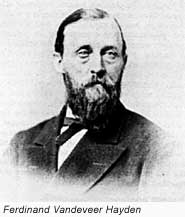 The intervening American Civil War stopped all attempts to explore the region, and Hayden would not be able to fulfill his mission to explore the area for another 11 years. The intervening American Civil War stopped all attempts to explore the region, and Hayden would not be able to fulfill his mission to explore the area for another 11 years.
In 1871 Hayden led a second, larger expedition, which was now government sponsored, to the Yellowstone region. He compiled a comprehensive report on Yellowstone which included large-format photographs by William Henry Jackson and paintings by Thomas Moran. This report helped to convince the U.S. Congress to withdraw this region from public auction. Then on March 1, 1872, President Ulysses S. Grant signed a bill into law that created Yellowstone National Park.

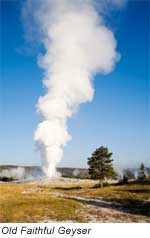 Yellowstone Caldera is the largest volcanic system in North America. It has been termed a "supervolcano" because the caldera was formed by exceptionally large explosive eruptions. It was created by a cataclysmic eruption that occurred 640,000 years ago that released 1,000 cubic kilometers of ash, rock and pyroclastic materials (this was 800 times larger than Mount St. Helens' 1980 eruption), forming a crater nearly a kilometer deep and 40 by 70 kilometers in area (25 by 45 mi). Preserved within Yellowstone are many geothermal features and some 10,000 hot springs and geysers, 62% of the planet's known total. The superheated water that sustains these features comes from the same hot spot described above. The most famous geyser in the park, and perhaps the world, is Old Faithful Geyser (located in Upper Geyser Basin), but the park also contains the largest active geyser in the world, Steamboat Geyser in the Norris Geyser Basin. Yellowstone Caldera is the largest volcanic system in North America. It has been termed a "supervolcano" because the caldera was formed by exceptionally large explosive eruptions. It was created by a cataclysmic eruption that occurred 640,000 years ago that released 1,000 cubic kilometers of ash, rock and pyroclastic materials (this was 800 times larger than Mount St. Helens' 1980 eruption), forming a crater nearly a kilometer deep and 40 by 70 kilometers in area (25 by 45 mi). Preserved within Yellowstone are many geothermal features and some 10,000 hot springs and geysers, 62% of the planet's known total. The superheated water that sustains these features comes from the same hot spot described above. The most famous geyser in the park, and perhaps the world, is Old Faithful Geyser (located in Upper Geyser Basin), but the park also contains the largest active geyser in the world, Steamboat Geyser in the Norris Geyser Basin.
Yellowstone is widely considered to be the finest megafauna wildlife habitats in the lower 48 states. Animals found in the park include the majestic American bison (buffalo), grizzly bear, black bear, elk, moose, mule deer, pronghorn, wolverine, bighorn sheep and mountain lion (puma). The Yellowstone Lake Cutthroat Trout is a highly sought after trophy fish by anglers yet has been threatened in recent years by the suspicious introduction of lake trout that compete for spawning grounds and are known to consume smaller cutthroat trout.
 A controversial decision by the U.S. Fish and Wildlife Service (which oversees threatened and endangered species), is the recent reintroduction of wolves into the park's ecosystem. For many years the wolves were hunted and harassed until they become locally extinct in the 1930s. The smaller cousin of the wolf, the coyote, then became the park's top predator. However, the coyote is not able to bring down any large animal in the park and the result of this lack of a top predator on these populations was a marked increase in lame and sick megafauna. Since the reintroduction of wolves in the late 1990s this trend has started to reverse. A controversial decision by the U.S. Fish and Wildlife Service (which oversees threatened and endangered species), is the recent reintroduction of wolves into the park's ecosystem. For many years the wolves were hunted and harassed until they become locally extinct in the 1930s. The smaller cousin of the wolf, the coyote, then became the park's top predator. However, the coyote is not able to bring down any large animal in the park and the result of this lack of a top predator on these populations was a marked increase in lame and sick megafauna. Since the reintroduction of wolves in the late 1990s this trend has started to reverse.
|

